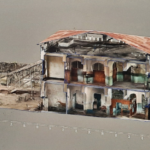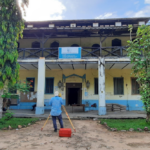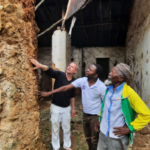


The town of Pangani in north-eastern Tanzania was once an important trading town on the Swahili coast of East Africa. The first major uprising against German colonial expansion, the so-called ‘Arab Uprising’ or ‘Abushiri Rebellion’, began here in 1888. After its suppression, Pangani became the seat of the regional administration in the ‘protectorate’ of German East Africa. Due to the relocation of trade routes after the end of German colonial rule in 1916, the town lost its importance. However, the historic city center of Pangani with its local, Indian, Arab-Omani-Zanzibari, German and British elements still bears witness to the city’s former importance.
Since 2023, the “Pangani Shared Colonial Heritage Project”, led by Cornelia Kleinitz, has been bringing together specialists from the DAI with colleagues from the Universities of Dar es-Salaam and Cambridge, the National Museum of Tanzania, the Pangani District Administration, local NGOs and other actors from the local community in a productive exchange on how to deal with the complex legacy of (German) colonialism. The fieldwork between October and December 2023, funded by the Cultural Preservation Program (KEP) of the German Federal Foreign Office and the DAI, focused on the site of the ‘German Boma’, the main building of the colonial administration, but also documented other evidence of German colonial rule in the urban area.
The history of the Boma and its outbuildings was investigated as part of an initial building survey. The originally Arab building of the Boma had been rebuilt several times and adapted to the respective requirements of the German and British colonial and Tanzanian district administrations. The current condition of the buildings was provisionally evaluated during the 2023 season and visualized through extensive 3D-documentation and modelling. A catalogue of urgent measures to preserve the buildings was drawn up and local discussions on the future use of the buildings were supported. At the same time, numerous archival documents were analyzed and a heritage GIS was created as part of the project. Excavations on the site of the Boma brought to light numerous finds from across the 19th century.
Interviews with the local population revealed the complexity of the memory of the colonial past and the challenges involved in coming to terms with it. This is particularly evident in the controversial assessment of the leader of the uprising against German colonial expansion, Abushiri/Bushiri bin Salim al-Harthi, by various population groups. Some emphasize his resistance to colonization, while others stress his role as a plantation owner and owner of slaves, whose descendants still live in the Pangani area today.
Members

Dr. Cornelia Kleinitz
KAAK
cornelia.kleinitz@dainst.de

Dipl-Ing. Christian Hartl-Reiter
KAAK
christian.hartl-reiter@dainst.de
Cooperation partners
Dr. Elinaza Mjema
University of Dar es-Salaam
Dr. Maximilian Chami
University of Dar es-Salaam
Severine Kizito, B.A.
Lenga Mbali (Director)
Erick Ntikachika, B.A.
District of Pangani
Adson Ndyanaro, M.A.
National Museum of Tanzania
Prof. Dr. Paul Lane
University of Cambridge
Figure captions
Fig. 1 Computer-aided work on the 3D-model of the Boma at Pangani [Measurements, photos and graphics: Christian Hartl-Reiter, DAI-KAAK]
Fig. 2 Surverying work at the Boma in 2023 [Photo: Cornelia Kleinitz, DAI-KAAK]
Fig. 3 Evaluation of the condition of buildings on the site of the Boma [Photo: Cornelia Kleinitz, DAI-KAAK]